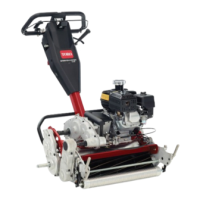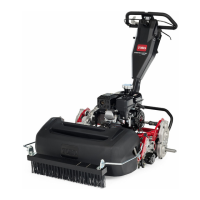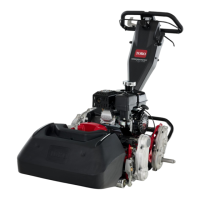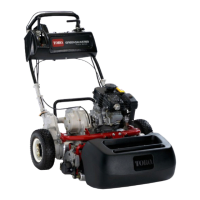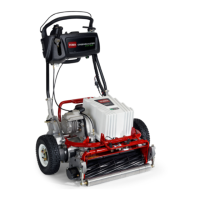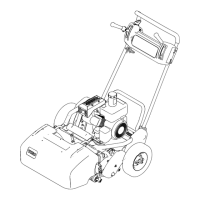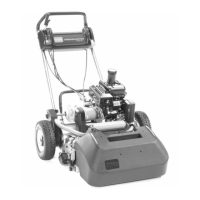Do you have a question about the Toro GREENSMASTER 1000 and is the answer not in the manual?
Explains the mower's purpose and intended use for professional commercial applications.
Emphasizes reading the manual, paying attention, and avoiding distractions for safe operation.
Highlights the visibility and importance of safety decals for hazard awareness.
Lists parts to verify shipment and their installation procedures.
Lists included media like manuals and certificates for pre-operation review.
Step-by-step instructions for attaching and securing the handle to the mower.
Details on how to adjust the handle position for operator comfort and control.
Steps for installing the transport-wheel shafts, including applying thread-locking adhesive.
Instructions for attaching transport wheels, inflating tires, and lowering the machine.
Lists necessary adjustments for the cutting unit before operation.
Guidance on installing the Operator Presence Kit to comply with safety standards.
Instructions for applying production-year and CE-mark decals as per CE standards.
Steps for grasping and sliding the grass basket onto the mounting rods.
Details the 8-hour break-in period and the importance of monitoring for minor difficulties.
Lists the main control components of the mower.
Describes the location and operation of the traction-drive lever.
Explains the throttle control's function and connection to the carburetor.
Details the location and function of the engine start/stop switch.
Identifies the service brake location and its use for slowing or stopping.
Instructions for engaging and disengaging the reel drive.
Instructions on how to use the choke lever for cold engine starting.
Explains how to control fuel flow using the shutoff valve lever.
Covers general safety rules and precautions before starting the machine.
Outlines critical safety measures for handling and storing fuel.
Instructions for checking the engine oil level before each use or daily.
Specifies recommended fuel, octane rating, and acceptable ethanol content.
Highlights hazards of fuel handling, flammability, and static electricity.
Lists bedbar aggressiveness and bedknife height of cut ranges for different turf conditions.
Details roller types and specifications for clip and traction kits.
Warns that damaged interlock switches can cause unexpected operation and injury.
Steps for transporting the mower over shorter distances using transport wheels.
Guidance on safely transporting the machine over longer distances using a trailer.
General safety guidelines for operating the machine, including clothing and attention.
Explains how to control fuel flow using the shutoff valve lever.
Details safety precautions for operating the machine on slopes to prevent rollovers.
Step-by-step guide to starting the engine, including lever and choke positions.
Instructions for safely shutting down the engine and securing the machine.
Best practices for mowing, including grass clipping lubrication and direction.
Steps to follow after completing mowing operations and transporting the machine.
Safety measures to take after operating the machine, including cleaning and cooling.
Guidance on transporting the machine away from the job site after use.
Safety precautions to follow before, during, and after performing maintenance.
A schedule outlining maintenance tasks and their recommended service intervals.
A list of daily checks to ensure the machine is in good working order.
Section to record inspection details and areas needing attention.
Essential steps to take before performing any maintenance or adjustments on the machine.
Instructions for lubricating the machine's grease fittings every 25 hours.
Safety precautions specific to engine maintenance, like avoiding overspeeding.
Guidance on filling the engine crankcase with the correct viscosity oil.
Specifies intervals for changing the engine oil and warnings about hot oil.
Procedures for cleaning or replacing foam and paper air filter elements.
Instructions for inspecting, gapping, and installing the spark plug.
Steps for adjusting or replacing the traction-interlock switch for proper safety function.
Guide to adjusting the service/parking brake if it slips during operation.
General instructions on ensuring proper belt tension for machine operation.
Procedure for checking and adjusting the tension of the reel-drive belt.
Steps to check and adjust the tension of the traction-drive belt.
Procedure to check and adjust the tension of the differential belt.
Instructions for adjusting the primary V-belts and ensuring pulley alignment.
Detailed steps for removing the old belt and installing a new differential belt.
Steps to remove slack from the traction control cable for proper operation.
Safety precautions when inspecting or servicing the cutting unit reel and blades.
Procedure to ensure the rear drum and reel are level for optimal cutting.
Steps for adjusting the bedknife to achieve proper contact with the reel.
How to adjust the machine's height-of-cut using the gauge bar and adjusting screws.
How to adjust the grass shield height for optimal grass discharge into the basket.
Steps to adjust the cut-off bar for clean discharge of clippings from the reel.
How to determine if the bedbar is standard or aggressive based on mounting ears.
Steps to remove the bedbar by backing out the adjuster screw and loosening jam nuts.
Instructions for installing the bedbar, securing it with bolts and washers.
Steps to prepare for and perform reel backlapping using a backlapping machine.
Safety rules to follow when storing the machine, including fire prevention.
Procedures for cleaning, fuel system preparation, and storing the machine for long periods.
| Engine Displacement | 118 cc |
|---|---|
| Drive System | Rear roller |
| Fuel Type | Gasoline |
| Engine Type | 4-cycle |
| Cutting Width | 21 inches |
| Fuel Tank Capacity | 0.83 gallons |
